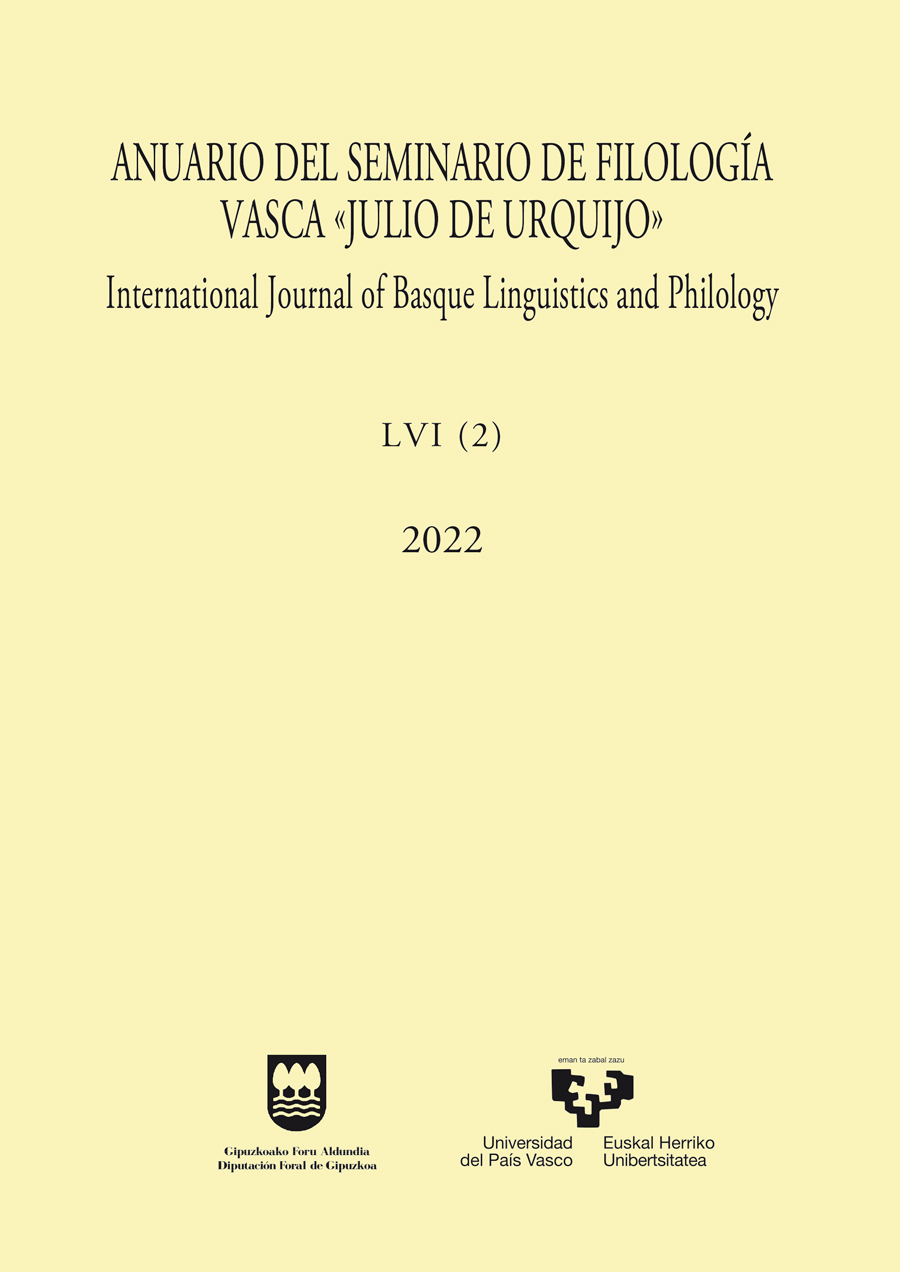Diachronic development of the /RT/ consonant group and the Roncalese evidence: revising some framework(s)
##plugins.themes.bootstrap3.article.main##
##plugins.themes.bootstrap3.article.sidebar##
Abstract
In this article, we will analyze the opposition of occlusives posterior to n-/l- that have been debated in the history of Basque. Until recently, it was argued that the voiced stop is the oldest sound after the lateral and the nasal, as found in Roncalese and Souletin. Mitxelena (1961), however, argued the opposite clearly and concisely. We will prove this, together with the grammaticalization and “Trask’s law”, through 17th-century letters by Gabriet Etxart and Miguel Ros. Thus, we will show that the evolution of occlusives was morphological at some point. Then, we will explain in detail how it was phonologically disseminated and how it spread from its old legacy to borrowings. In order to do so, it is essential to bear in mind both sociolinguistic conditions and differences we have found in the corpus.
How to Cite
##plugins.themes.bootstrap3.article.details##
Roncalese, Basque dialects, Diachronic dialectology, Miguel Ros, Basque from Erronkari, posterior occlusives of n-/l-
Azkue, Resurrección María. 1931. Particularidades del dialecto roncalés. Euskera 12. 207-406.
Bilbao, Gidor & Joseba A. Lakarra. 2016. Etxart-Ros gutuneria. (Monumenta Linguae Vasconum III. Jardunaldietan aurkeztutako komunikazio argitaragabea, Gasteiz, 2016/12/20). https://ehutb.ehu.eus/video/58c67369f82b2be4338b45b0.
Etxart, Gabriel & Miguel Ros. 1616-1617. Gutuneria (Gidor Bilbao, Ricardo Gómez, Joseba A. Lakarra, Julen Manterola, Céline Mounole & Blanca Urgellen edizio-zirriborro argitaragabea, Gasteiz: UPV/EHU, 2013).
Gómez, Ricardo. 1991. Erronkarierazko dotrina argitaragabe bat: edizioa eta azterketa. In Joseba A. Lakarra (arg.), Memoriae L. Mitxelena magistri sacrum (ASJUren Gehigarriak 14), I, 375-426. Donostia: Gipuzkoako Foru Aldundia.
Hualde Mayo, Pedro Prudencio. 1934-1935. Evangelio de San Mateo traducido al vascuence roncalés de Vidángoz. RIEV 26(1). 527-548.
Idoate, Florencio. 1977. La comunidad del valle de Roncal. Iruñea: Nafarroako Diputazioa.
Irigoien, Alfonso. 1957. Cartas de Mariano Mendigacha a D. Resurrección María de Azkue. Euskera 2. 119-169.
Janda, Richard D. 2003. Phonologization as the start of dephoneticization –Or, on sound change and its aftermath: Of extension, generalization, lexicalization and morphologization. In Brian D. Joseph & Richard D. Janda (arg.), The handbook of historical linguistics, 401-422. Blackwell: Oxford.
Lafon, René. 1999. Vasconiana (Iker 11). Bilbo: Euskaltzaindia.
Lakarra, Joseba A. 1995. Reconstructing the root in Pre-Proto-Basque. In José I. Hualde, Joseba A. Lakarra & Robert L. Trask (arg.), Towards a history of Basque language, 189-206. Amsterdam & Philadelphia: John Benjamins.
Lakarra, Joseba A. 2011. Gogoetak euskal dialektologia diakronikoaz: Euskara Batu Zaharra berreraiki beharraz eta haren banaketaren ikerketaz. In Irantzu Epelde (arg.), Euskal dialektologia: lehena eta oraina, 155-241. Bilbo: UPV/EHU.
Lakarra, Joseba A. 2013. Euskararen historiaurrearen berreraiketa sakonagorako: forma kanonikoa, tipologia holistikoa, kronologia eta gramatikalizazioa. In Ricardo Gómez, Joaquín Gorrochategui, Joseba A. Lakarra & Céline Mounole (arg.), Koldo Mitxelena Katedraren III . Biltzarra, 275-324. Gasteiz: UPV/EHU.
Lakarra, Joseba A. 2016. Gramatikalizazioa, morfemen forma kanonikoak eta berreraiketa morfologikoaren bide berriak. In Gotzon Aurrekoetxea, Jesus Mari Makazaga & Patxi Salaberri (arg.), Txipi Ormaetxea omenduz. Hire bordatxoan, 175-192. Bilbo: UPV/EHU.
Lakarra, Joseba A. 2018. Euskararen historiaurrea. In Joaquín Gorrochategui, Iván Igartua & Joseba A. Lakarra (arg.), Euskararen historia, 23-229. Gasteiz: Eusko Jaurlaritza.
Leizarraga, Joanes. 1990 [1571]. Iesus Christ gure Iaunaren Testamentu Berria. Bilbo: Euskaltzaindia.
Martinet, André. 1950. De la sonorisation des occlusives initiales en basque. Word 6. 224-233. https://doi.org/10.1080/00437956.1950.11659382.
McColl Millar, Robert (arg.). 2015. Trask’s Historical Linguistics. Londres & New York: Routledge.
Mitxelena, Koldo. 1954. La posición fonética del dialecto vasco del Roncal. Via Domitia 1. 130-157 (Berrargit. OC 7, 611-647).
Mitxelena, Koldo. 1955. La Doctrina Cristiana de Betolaza. ASJU 2. 41-60 (Berrargit. OC 11, 187-204).
Mitxelena, Koldo. 1957. Las antiguas consonantes vascas. In Diego Catalán (arg.), Miscelánea homenaje a André Martinet, I, 113-157. Tenerife: La Lagunako Unibertsitatea (Berrargit. OC 7, 57-91).
Mitxelena, Koldo. 1961. Fonética histórica vasca. Donostia: Gipuzkoako Foru Aldundia (2. argit. osatua, 1977. Berrargit. OC 6).
Mitxelena, Koldo. 1963. Lenguas y protolenguas. Salamanca: Salamancako Unibertsitatea (Berrargit. ASJUren Gehigarriak 20. Donostia: Gipuzkoako Foru Aldundia. 1990; berrargit. OC 1, 1-98).
Mitxelena, Koldo, Juan J. Beloqui, Jesús Elósegui & Pilar Sansinenea de Elósegui. 1953. Contribución al conocimiento del dialecto roncalés. BAP 9. 499-536 (Berrargit. OC 7, 571-608).
Monteano, Peio J. 2017. El iceberg navarro. Euskera y castellano en la Navarra del siglo xvi. Iruñea: Pamiela.
Mounole, Céline & Ricardo Gómez. 2018. Euskara zahar eta klasikoa. In Joaquín Gorrochategui, Iván Igartua & Joseba A. Lakarra (arg.), Euskararen Historia, 469-541. Gasteiz: Eusko Jaurlaritza.
OEH = Euskaltzaindia. 2021. Orotariko Euskal Hiztegia. 10. argit. https://www.euskaltzaindia.eus/oeh [2023/01/30].
Pagola, Rosa M., Itziar Iribar & Juan J. Iribar. 1997. Bonaparte ondareko eskuizkribuak. Erronkariera. Bilbo: Deustuko Unibertsitatea.
Sarasola, Ibon. 1997. Euskal hitz altxorraz. ASJU 31(2). 617-642.
Trask, Robert L. 1995. On the history of the non-finite verb forms in Basque. In José I. Hualde, Joseba A. Lakarra & Robert L. Trask (arg.), Towards a history of the Basque language, 207-234. Amsterdam & Philadelphia: John Benjamins.

This work is licensed under a Creative Commons Attribution-NonCommercial-NoDerivatives 4.0 International License.
This works is licensed under a Creative Commons Attribution-NonCommercial-NoDerivatives 4.0 International License.


